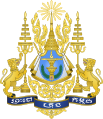Gajasimha
Appearance

The gajasimha or gajasiha (from Sanskrit: gaja+siṃha / Pali: gaja+sīha) is a mythical hybrid animal in Hindu mythology, appearing as a sinha or rajasiha (mythical lion) with the head or trunk of an elephant. It is found as a motif in Indian and Sinhalese art,[1] and is used as a heraldic symbol in some Southeast Asian countries, especially Cambodia and Thailand. In Siam (pre-modern Thailand), the gajasimha served as the symbol of the kalahom, one of the king's two chief chancellors. It appears as a supporter in the coat of arms of Siam, in use from 1873 to 1910, and the royal arms of Cambodia, officially adopted in 1993.
Gallery
[edit]-
Ivory throne leg, Eastern Ganga dynasty
-
Architectural motif, Gwalior Fort, Madhya Pradesh, India
-
Lintel detail from Prasat Prei Kmeng, Siem Reab, Cambodia
-
Door painting, Wat Arun, Thailand
-
Statue, Ministry of Defence, Thailand
-
Royal crematorium of King Bhumibol Adulyadej, Thailand
In heraldry
[edit]-
Royal arms of Cambodia
-
Coat of arms of Siam
-
Coat of arms of the Thai 1st Infantry Regiment, King's Close Bodyguard
-
Seal of the Minister of Defence, Siam
-
Emblem of the Office of the Prime Minister of Thailand
See also
[edit]References
[edit]Wikimedia Commons has media related to Gajasimha.
- ^ Bane, Theresa (2016). Encyclopedia of beasts and monsters in myth, legend and folklore. McFarland. p. 132. ISBN 9780786495054.











